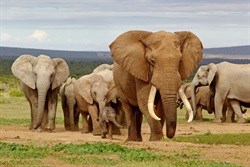World Elephant Day on 12 August presents an opportunity to take a sobering view of the current situation of elephants on the continent and in South Africa. So far this year, the number of elephants being killed in Africa remains unacceptably high.
Southern Africa is effectively now the last fortress for rhinos on the continent. This has to represent a level of conservation success on behalf of the region and one which is now being reflected in elephant populations, as Southern Africa now houses 55% of Africa's elephants compared to 20 years ago where the figure was only 21%.
West Africa on the other hand has lost nearly all its elephants and now has only 1.6% of the continent's population. Central Africa and East Africa are experiencing extreme levels of poaching, and the threat of illegal killings is already being felt in Southern Africa. An example of this is Selous Game Reserve in Tanzania, which had a population of between 50,000 and 80,000 elephants just four years ago, but when a new census was conducted in 2014 it was discovered that the population had been decimated to approximately 13,000.
Loss of genes
Another concern is the loss of the valued big tusk genes that, once lost, would be gone forever. A large tusker generally refers to an elephant with tusks that are over 50kg in weight. The number of these large animals has decreased due to poaching and, in some cases, due to hunting. These large iconic elephant bulls are being targeted by poachers as was seen recently with the poaching of possibly Africa's largest tusker, Satao, in Kenya on 30 May 2014. This magnificent specimen was estimated to have been born in 1968 and at the age of 46 his tusks were longer than 2m and weighed more than 50kg a side. Satao was tragically killed by a poison arrow.
"These iconic specimens are ambassadors for an iconic species for the African continent and its culture. Like the rhino, the survival of elephants and the way that we manage the remaining populations lies in our hands," says WESSA's Biodiversity Unit leader, Chris Galliers. "We see time and time again that the survival of these flagship species is directly linked to the level of political will to protect them. It would be the most senseless act of greed if we were not able to hand over healthy wild populations of African elephants to the generations that follow."
Unreported poaching
Chairman of the WESSA Board, Dr Richard Lewis said, these giants, who develop deep emotional bonds between themselves, and display a level of caring and intelligence seemingly beyond most other mammals, are being systematically slaughtered at an overwhelming rate but which goes largely unreported due to the massive media focus on rhino poaching. "People across the world have to be made aware of the plight of the elephant, so that they can voice their opposition and bring pressure to bear on authorities in Africa to do more to protect these magnificent animals."
WESSA believes that South Africa could play a leading role at both a political and management level in securing the future of elephants on the continent. They also urge all South Africans to become more aware of the plight of elephants as we do not want the dire situation of our rhino populations to be replicated.



































